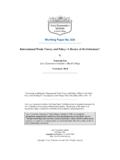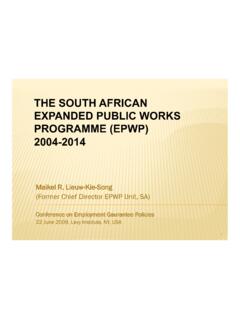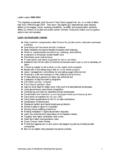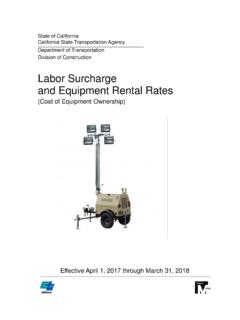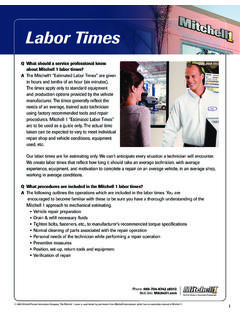Transcription of Unit Labor Costs in the Eurozone: The …
1 Working Paper No. 651 Unit Labor Costs in the eurozone : The Competitiveness Debate Again* by Jesus Felipe Utsav Kumar Asian Development Bank, Manila, Philippines February 2011 * This paper represents the views of the authors and not those of the Asian Development Bank, its executive directors, or the member countries that they represent. We are very grateful to our colleague Joao Farinha for encouraging us to write this paper and for his comments and suggestions. The usual disclaimer applies. Contacts: (corresponding author); The Levy Economics Institute Working Paper Collection presents research in progress by Levy Institute scholars and conference participants.
2 The purpose of the series is to disseminate ideas to and elicit comments from academics and professionals. Levy Economics Institute of Bard College, founded in 1986, is a nonprofit, nonpartisan, independently funded research organization devoted to public service. Through scholarship and economic research it generates viable, effective public policy responses to important economic problems that profoundly affect the quality of life in the United States and abroad. Levy Economics Institute Box 5000 Annandale-on-Hudson, NY 12504-5000 Copyright Levy Economics Institute 2011 All rights reserved 1 ABSTRACT Current discussions about the need to reduce unit Labor Costs (especially through a significant reduction in nominal wages) in some countries of the eurozone (in particular, Greece, Ireland, Italy, Portugal, and Spain) to exit the crisis may not be a panacea.
3 First, historically, there is no relationship between the growth of unit Labor Costs and the growth of output. This is a well-established empirical result, known in the literature as Kaldor s paradox. Second, construction of unit Labor Costs using aggregate data (standard practice) is potentially misleading. Unit Labor Costs calculated with aggregate data are not just a weighted average of the firms unit Labor Costs . Third, aggregate unit Labor Costs reflect the distribution of income between wages and profits. This has implications for aggregate demand that have been neglected. Of the 12 countries studied, the Labor share increased in one (Greece), declined in nine, and remained constant in two.
4 We speculate that this is the result of the nontradable sectors gaining share in the overall economy. Also, we construct a measure of competitiveness called unit capital Costs as the ratio of the nominal profit rate to capital productivity. This has increased in all 12 countries. We conclude that a large reduction in nominal wages will not solve the problem that some countries of the eurozone face. If this is done, firms should also acknowledge that unit capital Costs have increased significantly and thus also share the adjustment cost . Barring solutions such as an exit from the euro, the solution is to allow fiscal policy to play a larger role in the eurozone , and to make efforts to upgrade the export basket to improve competitiveness with more advanced countries.
5 This is a long-term solution that will not be painless, but one that does not require a reduction in nominal wages. Keywords: Competitiveness; eurozone ; Income Distribution; Unit Labor Costs JEL Classifications: D31, D33, E25, J30 21. INTRODUCTION Discussions about the need to regain competitiveness in the euro area have taken center place in policy forums in the context of the current crisis. The issue is particularly important for Greece, Ireland, Italy, Portugal, and Spain. No matter how the crisis started, analysts have concluded that these countries suffer from a competitiveness problem ( , workers are too expensive, especially given their Labor productivity).
6 Given that devaluation is not possible because they all use the euro, and that the monetary union has imposed fiscal rigidity and removed monetary independence, it appears that adjustment has to come through the Labor market. Therefore, policy discussions have focused on analyses of unit Labor Costs . A number of economists have concluded that to close the competitiveness gap, in particular with Germany, requires downward adjustments in relative wages in these five countries (Black 2010), , the so-called internal Unit Labor Costs are defined as the ratio of a worker s total compensation, or money-wage ( , the nominal wage rate plus all other Labor -related Costs to the firm such as payments in-kind related to Labor services, social security, severance and termination pay, and employers contributions to pension schemes, casualty, and life insurance, and workers compensation, and, in some cases, payroll taxes as well as fringe benefits taxes, etc.)
7 , to Labor productivity. Assuming the numerator is measured in euros per worker and the denominator is measured in numbers of pencils per worker, the unit Labor cost is measured in euros per pencil ( , total Labor cost per unit of output, or the cost in terms of Labor for the products we get). Algebraically: /( / )qnulcwq L= (1) where wn denotes total Labor compensation, q is physical output, and L is employment ( , number of workers). 1 Paul Krugman, for example, has written extensively on his blog advocating this view of the problem. For example, 3 Firms, obviously, do care about unit Labor Costs because they track the relationship between their total Labor Costs and how productive workers are.
8 If a firm s unit Labor cost increases, and even more so vis- -vis those of its competitors, most likely it will lose market share and its growth expectations will be negatively affected. The solution to this problem is a combination of wage restraint and Labor productivity increase, the latter usually achieved by introducing Labor -saving techniques that are profitable. Increasing productivity is not easy and does not happen overnight. Besides, the determinants of productivity are not well known. In a recent survey, Syverson (2010) summarizes a wealth of literature and classifies its determinants into two groups: (i) factors that operate primarily within firms and under the control of the management;2 and (ii) factors external to the firm.
9 The latter operate indirectly through the environment by affecting producers willingness and ability to harness factors that affect Syverson admits that it is not clear which one of the determinants is more important quantitatively and further research is needed. In discussions, often the policy recommendation to increase productivity is to reform, especially the Labor A decrease in the nominal wage rate faces all sorts of psychological and legal problems (Blanchard 2007). The question is whether this is the solution to the current crisis. Would workers in countries like Spain, where unemployment affects over a fifth of the Labor force, accept a reduction in nominal wages to maintain their firms competitiveness and this way keep their jobs?
10 A key issue that seems to have been forgotten by the participants in this debate is the well-documented lack of empirical relationship between the growth in unit Labor Costs and output growth. This is referred to in the literature as Kaldor s paradox (Kaldor 1978; see chapter 4 of McCombie and Thirlwall [1994] for a discussion). Kaldor found, for the postwar period, that those countries that had experienced the greatest decline in their price competitiveness ( , highest increase in unit Labor Costs ) also had the greatest 2 Syverson mentions the following: (a) managerial practice/talent; (b) higher-quality general Labor and capital inputs; (c) information technology and research and development; (d) learning-by-doing; (e) product innovation; and (f) firm structure decisions.




